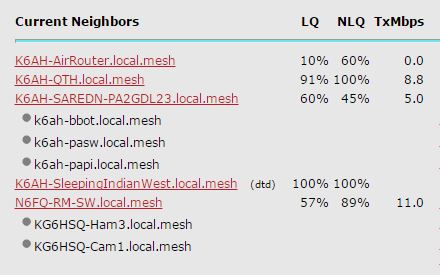I'm planning to set up a 2.4GHz and a 5GHz node at my house in east Milpitas. However, now that we have a choice of channels (0, -1, -2) on 2.4GHz gear, where do folks usually set up in the bay area? Is -2 and 10MHz b/w a good default to assume? Is channel 0 at 20MHz b/w more typical? Or are these the wrong questions?
On a related note, does AREDN have a "deployed mesh nodes" map similar to broadband-hamnet's site? It would be useful for both casual experimentation and for EMCOMM linking.
73, Jeff KG6KCO
On a related note, does AREDN have a "deployed mesh nodes" map similar to broadband-hamnet's site? It would be useful for both casual experimentation and for EMCOMM linking.
73, Jeff KG6KCO

(BTW, channel 0 is NOT an option)
re:
"On a related note, does AREDN have a "deployed mesh nodes" map similar to broadband-hamnet's site? It would be useful for both casual experimentation and for EMCOMM linking."
Thanks for asking.
It sure would be cool if node operators themselves could AUTOMATICALLY place (and remove) their node(s) on that map...
Would also be cool if node operators wanting to mesh with a nearby node could get all the details (ie. band, freq/channel/bandwidth) from that map....
Would really be cool if a node operator could easily specify WHERE their node is simply by a click (and maybe a drag).....
;-)
re: a mesh map, I guess your flippant reply means "no, and don't expect one".
And sorry, I was not being flippant on the map thing...
Just my poor attempt at a teaser.... ;-)
For now, is there any manual map that one can check or contribute to? I know a hack can be done with KML (is it?) and Google Maps.
something like this:
Well, v3.16.1.0b01 was just released... have at it ;-) You'll find it under Experimental Builds
Andre
Channel -1 is encroached partially by the 20 MHz-wide WIFI channel 1. 20 MHz bandwidth uses the channel it's centered on, plus the two adjacent channels, plus half of each channel a next to them. So channel 1 uses half of channel -1, all of channels 0, 1, 2, and half of channel 3. Therefore, channel -2 is the only real clear channel we have as hams.
Andre
What is the maximum throughput in Mb/s at 10MHz b/w that one would expect on channel -2? I'm thinking two Nanostation M2s with 100% link quality reported in OLSR
This is taken from our beta firmware, but you can see I'm getting throughputs of 5, 8.8, and 11 Mpbs transmission speeds to neighbors on channel -2. Even over somewhat crummy link qualities. I know Joe has gathered some real remarkable statistics if we can get him to share them...

That on ch -2, you should only be considering 5Mhz or 10Mhz bandwidth.
20Mhz bandwidth on -2 is most likely of of band for the radio/filters as it spills down the spectrum too far.
-2 at 20MHz is GUARANTEED OUT OF BAND in the USA without doubt.
-2 = 2397 MHZ centered, width of 22MHz (802.11b/g is actually 22 wide while N is closer to 20 wide) 22/2=11 2397-11=2386 MHz a full 4Mhz below USA band plan for HAM's
10MHz mode is really 11MHz (not counting spllover) for the slower data rates so 2397-(11/2)=2391.5 giving you only 1.5MHz for any noise from the signals to dissipate below acceptable out of band limits.
-- Personally I find that tight, not sure I want to be that close.
Hi Jeff,
I agree that the map is a great start. I just put up a node in Morgan Hill on Ch -2 on a 15 dBi omni and I added the additional information in a forum post.
When you have a chance please check out my post as well.
73,
Frank
WA2KWR